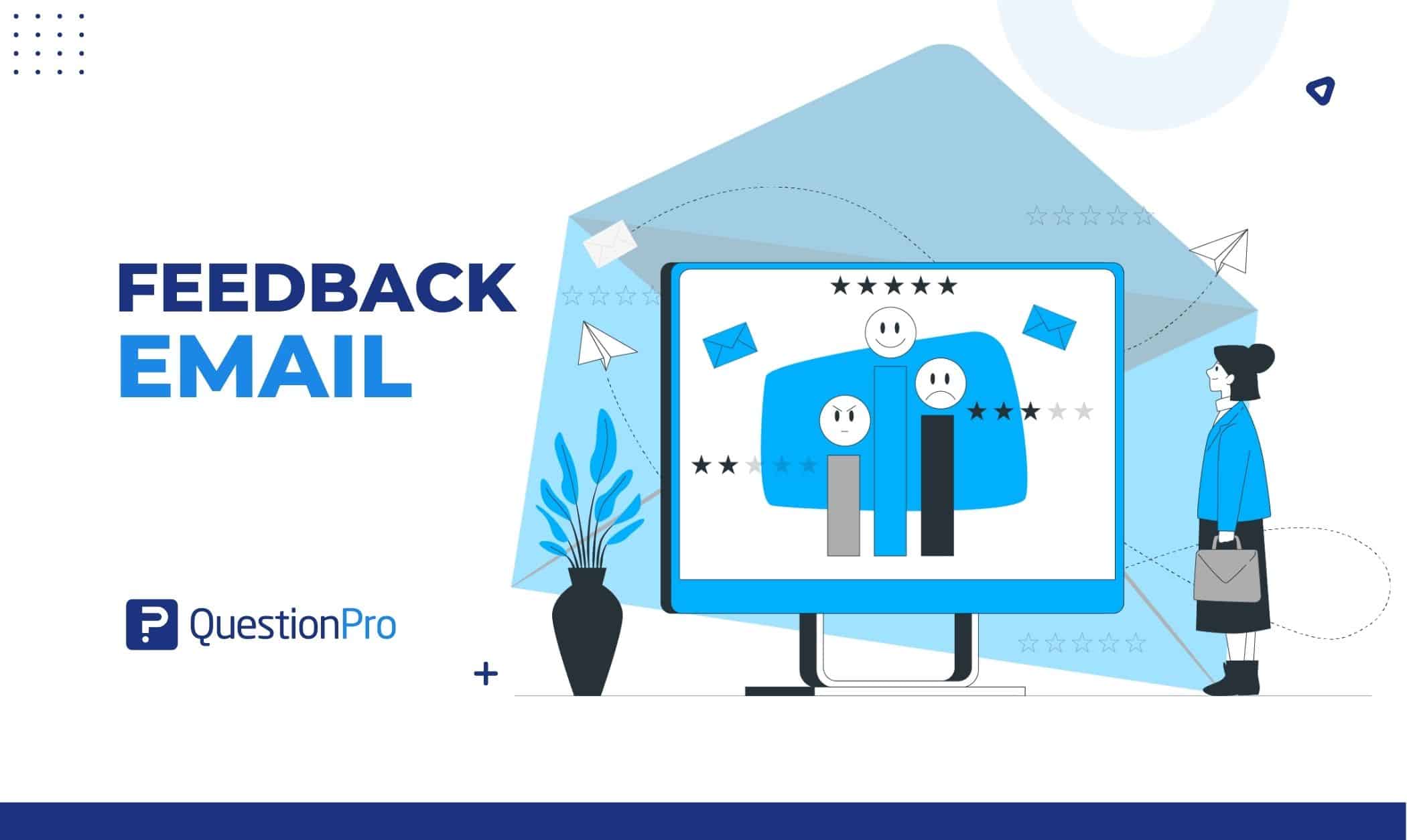
Customer feedback email is invaluable for developing better goods, services, and operations. But just because you understand the significance of feedback doesn’t imply you automatically know how to collect it.
Feedback emails can be a powerful way to build good relationships with customers. It shows that the sender cares about the product or service and wishes to improve it. Customer comments may make the recipient feel valued and appreciated and build trust and goodwill between sender and recipient.
In addition, the consumer might feel more invested in the product or service and be more likely to keep using it if the recipient takes the opinion seriously and uses it to make improvements.
We’ll learn what a feedback email is and how to write one in this blog. We’ll also discuss the importance of feedback emails and an email template.
What is Feedback Email?
A feedback email is a type of email communication sent by a business, organization, or individual to gather opinions, insights, or comments from customers, clients, employees, or stakeholders.
The primary purpose of a feedback email is to solicit feedback, suggestions, or responses on a specific topic, product, service, event, or experience.
The following are some examples of formats for your feedback emails:
- Inviting them to respond with their thoughts and feedback
- Including Likert scale-type questions in a survey
- Distributing surveys with either multiple-choice or free-form questions
- Promoting product or service improvement by seeking feedback from consumers on its various aspects
Importance of Feedback Email
Feedback email is important for a variety of reasons. It primarily offers the recipient helpful information about how the good or service is viewed. The remaining significance can be summed up as follows:
- It tells the recipient important things about how the product or service is being seen. This information can improve the product or service and ensure it meets the customer’s needs.
- It shows that the sender cares about the product or service and wants to help improve it, which can help build a relationship between the sender and the recipient.
- It can help improve the quality of products and services as a whole, which can make customers happier and lead to more sales.
- It can help find places where a product or service isn’t meeting customers’ needs and can give helpful information about how to fix those problems.
- It can be a great way to build a good reputation and keep customers returning.
Requesting feedback via feedback email is important for any business or organization wanting to grow and improve.
LEARN ABOUT: Email Surveys
Usability of Feedback Email
Feedback emails are commonly used for various purposes, including:
Customer Feedback
Businesses often send customer feedback surveys to customers to collect opinions on their products or services. This helps in improving customer satisfaction and making necessary improvements.
Employee Feedback
Organizations may use feedback emails to gather input from employees regarding workplace conditions, job satisfaction, or suggestions for improvement.
Event Feedback
After hosting events, organizers send customer feedback emails to attendees to understand their experiences and identify areas for enhancement.
Product Feedback
Companies can request feedback from their software, applications, or physical product users to identify bugs, usability issues, and feature requests.
Market Research
Researchers and marketing professionals use feedback emails to conduct surveys and collect valuable data on consumer preferences, trends, and behaviors.
Training and Workshops
Trainers and educators may send customer feedback emails to participants to assess the effectiveness of training programs and gather suggestions for future sessions.
Customer Feedback Email Template Format
When crafting customer feedback emails, it’s essential to make it clear, engaging, and easy for your customers to respond. Here are the key points to include in your customer feedback email templates:
1. Personalization:
Start the email by addressing the customer by their name. Personalization makes the email feel more genuine and relevant.
2. Greeting:
Begin with a friendly and polite greeting, such as “Dear [Customer’s Name],”
3. Introduction:
Begin with a brief introduction, expressing your appreciation for the customer’s business or recent interaction with your company.
For example, “We appreciate your recent purchase of [product/service] with us.”
4. Statement of Purpose:
Clearly state the purpose of the email, which is to gather feedback from the customer. Let them know that their opinion is valuable to you.
5. Request for Feedback:
Pose specific questions related to the product, service, or interaction you want customer feedback request on. Make the questions clear and concise, and consider using a rating scale or open-ended questions.
6. Options for Providing Feedback:
Offer multiple ways to request customer feedback, such as through an online survey, a link to a feedback form, or by responding directly to the email by the customer support team.
7. Assurance of Privacy:
Assure the customer that their feedback will be kept confidential and used solely for the purpose of improving your products or services.
8. Gratitude:
Express gratitude for the customer’s time and willingness to provide feedback. Show that you value their opinion.
9. Contact Information:
Include your contact information, such as a phone number or email address, so that the customer can reach out with any concerns or additional feedback.
10. Closing:
End the email with a closing statement, such as “Thank you for being a valued customer,” followed by a closing salutation like “Sincerely” or “Best regards” from the customer service team.
11. Signature:
Include your name, title, and the name of your company at the end of the email. This adds a personal touch and reinforces your brand.
12. Optional: Incentives or Rewards:
Consider offering incentives, such as discounts or entry into a prize draw, as a token of appreciation for the customer’s feedback.
13. Optional: Encourage Further Engagement:
Encourage the customer to stay connected with your brand by following your social media accounts or subscribing to your newsletter.
Customer Feedback Email Examples:
Example 1:
When sending a customer feedback email, it’s important to be clear, professional, and respectful. Here’s a format you can follow:
Subject Line: Your Feedback Matters to Us!
Dear [Customer’s Name],
I hope this email finds you well. At [Your Company Name], we value our customers’ opinions and constantly strive to improve our products and services. Your feedback is invaluable to us, and we appreciate you taking the time to share your thoughts.
[Optional: Begin with a brief thank you for their recent interaction with your company, such as a purchase, support request, or visit.]
We would like to hear about your recent experience with [specific product/service/interaction], and your input will help us enhance our offerings to meet your needs and expectations better.
Please take a few minutes to answer the following questions or provide any comments you may have:
- How satisfied are you with [specific product/service/interaction] on a scale of 1 to 5 (1 being very dissatisfied and 5 being very satisfied)?
- [Rating Scale]
- What aspects of [specific product/service/interaction] did you find most satisfying or enjoyable?
- What aspects of [specific product/service/interaction] do you think could be improved or enhanced?
- Do you have any additional comments, suggestions, or concerns you would like to share with us?
Your feedback is vital in helping us shape our future efforts. We genuinely appreciate your time and input. Rest assured that all responses will be kept confidential and used solely for the purpose of improving our products and services.
Thank you for being a valued customer, and we look forward to hearing from you. Your insights will help us serve you better.
Sincerely,
[Your Name]
[Your Title]
[Your Company Name]
[Contact Information: Phone number, email address, etc.]
[Optional: Include a link to an online survey or feedback form for ease of response.]
This format is adaptable to various feedback scenarios, whether you’re seeking input on a recent purchase, customer support interaction, or overall customer experience. Remember to keep the email concise and user-friendly to encourage a high response rate.
Example 2:
Another customer feedback email:
Dear valued customer,
We’re glad you chose our product or service. We’re always looking for ways to improve, so your feedback would be very helpful.
Tell us what you thought about the product or service you got. Were you happy with how it turned out? Did you run into any problems? Do you have any ideas for how we could get better?
You can tell us what you think by clicking the link below or emailing us.
[Survey Link]
[Email Address]
Thank you for taking the time to say something helpful. We care about what you think and are glad you’re helping us improve our product or service.
Best regards,
[Your Name]
Conclusion
Feedback email is a simple way to get valuable information from your employees, customers, or other important people about what they think about the products or services you need to improve and grow your business.
But the whole process, from doing feedback surveys to sending them out and analyzing the results, is time-consuming unless you use feedback software that you can trust.
A well-designed customer survey can help you get all the information you need to see where your business isn’t meeting the needs of your customers or employees, which obviously includes positive feedback and negative feedback.
Use the insights to bring about the expected change. Your business will be better positioned to tap into new markets, take advantage of new growth opportunities, and find unique ways to make money.
Feedback email is a great way to get in touch with people no matter why you need feedback. So go ahead and start collecting email feedback to gain insights and information that may surprise you in a good way.
With the help of QuestionPro, you can find out how to improve your business by regularly getting valuable feedback from your employees, customers, and other important people. The QuestionPro will help you determine how well you can collect information from email feedback messages.
You can ask the people you want to know what they think about this by giving them a survey.







